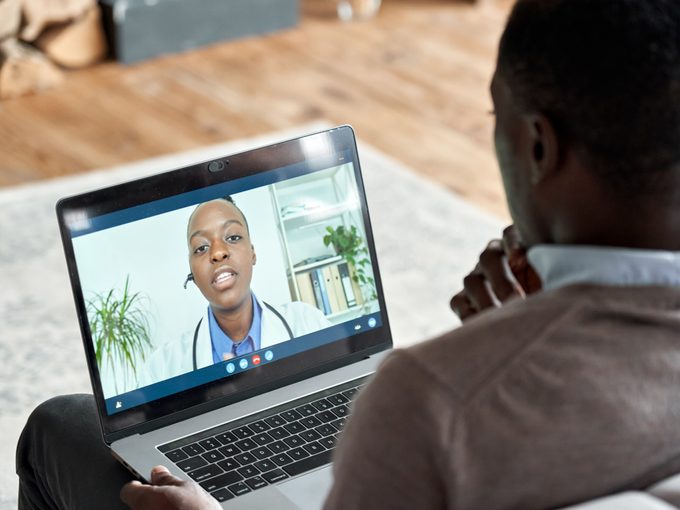Is Telehealth as Effective as In-Person Care? Here’s What the Experts Say
Virtual appointments are convenient and safe—but are they effective?

Last year, COVID-19 forced much of our lives online: work meetings migrated to Zoom, quarantinis replaced in-person happy hours. Medicine was no exception. In order to prevent the spread of the coronavirus, governments worldwide instructed their citizens to stay home when possible and avoid non-essential outings, including trips to hospitals and doctors’ offices. So, patients swapped in-person appointments for phone calls and video chats. Google searches for telehealth spiked. Before the pandemic, just one in 10 Canadians had used telehealth; by last May, half of them had.
To meet the increasing demand, North American and European governments, hospitals and private businesses have invested billions of dollars in new and existing virtual care services. The Canadian federal government, for one, earmarked $13.4 million for a trio of telehealth companies and a digital health “innovation hub,” while Loblaw Companies Ltd. invested $75 million in Maple, an app that facilitates online doctor consultations. As a result, hundreds of Shoppers Drug Mart stores are now outfitted with iPads that provide customers a direct link to Maple physicians.
Virtual visits are best suited to simple tasks, like refilling prescriptions, as well as diagnosing and treating conditions that rely on a doctor’s sense of sight—pink eye, rashes, varicose veins—or a patient’s description of symptoms, such as back pain, strep throat and UTIs. Telehealth also excels at monitoring chronic conditions, such as congestive heart failure, where doctors don’t need to provide a new diagnosis but simply check up on patients, monitor evolving symptoms and discuss the side effects of medication. Diabetes is also a good fit: people can upload blood sugar levels, dosing and other information for a nurse to review electronically.
Mental health counselling is easy to access digitally, too, though it comes with pros and cons. On the one hand, therapists may not be able to see body language, which can sometimes be a clue to understanding a client’s well-being, and a shoddy Internet connection can be particularly jarring during a difficult conversation. At the same time, there are patients who like it better. “Some providers even say having that extra bit of distance makes people more honest and less stressed to talk about difficult topics,” says Annette Totten, an associate professor at Oregon Health and Science University who has studied telehealth extensively.
When done right, Totten’s research shows, telehealth benefits both health-care providers and patients. It can significantly reduce hospital admissions, which frees beds for people in need of critical care—an especially crucial factor during the pandemic. And it’s a lot more convenient for patients, adds Michelle Greiver, a family doctor in Toronto whose entire practice shifted to telehealth when the pandemic hit. “They don’t have to take time off work or travel to our office,” she says.
Totten experienced that convenience firsthand last spring. When her husband accidentally spilled hot oil on his arm, she suggested they arrange a video call with his doctor instead of rushing to the hospital, where they risked getting infected with COVID-19. Over video chat, the doctor inspected Totten’s husband’s burn, instructed him how to bandage it and prescribed him painkillers.
According to a May 2020 survey by the Canadian Medical Association, 91 per cent of telehealth users were “very satisfied” with their experience. To ensure visits go smoothly, Totten recommends preparing for appointments with a list of questions and to ask for written instructions about next steps. Patients can avoid wasting precious minutes of their appointments by ensuring beforehand that their Internet connection is strong and that they have all the necessary software and hardware.
Online or off, some doctors are better than others. If patients aren’t satisfied with an experience, they can look for another telehealth provider—there are plenty. Many hospitals and public health systems have telehealth programs, and some startups offer instant access to doctors—for a fee. Maple, the Loblaw-backed app, charges between $49 and $99 for a one-off virtual visit.
Of course, there are times when telehealth just doesn’t cut it. “Diagnosis is an art, and doctors take in information from lots of places,” says Totten. “There are things that involve touch or smell that you’re not going to get through telehealth.” For example, doctors regularly use their hands to examine potential tumours, hernias and fractures, while a foul odour may hint at poor general health.
For maternal health, expectant mothers should still make the trip to the obstetrician. The same is true after birth, since babies can’t communicate their health concerns and regularly need immunizations. And urgent health matters—a broken bone, prolonged shortness of breath, symptoms of a heart attack or stroke—should still push patients to the ER, not their iPads.
Greiver expects the uptick in telehealth use to last after the pandemic. At her clinic, she says, much can be taken care of by phone. “I don’t think we will go back to as many in-person visits as before. It’s just not needed to provide the best possible care.”
Telehealth Intel
Are there virtual “walk-ins” if you don’t have a doctor?
Yes, many brick-and-mortar walk-in clinics have begun offering virtual visits during the pandemic. These appointments, which are covered by provincial health plans, may require you to book hours or even a day in advance, whereas services like Maple and GOeVisit can provide near-instant access to licensed doctors around the clock for a fee.
Who is using telehealth the most?
The demographic skews young and, at least prior to the pandemic, rural. According to a May 2020 survey by telehealth provider MDLive, 72 per cent of respondents aged 18 to 44 said they would “probably” or “definitely” use telehealth, whereas only 61 per cent of 45-to-65-year-olds said they would.
Do you need to worry about privacy?
Yes, within reason. Patients would be wise to ask their chosen provider what data-protection measure they take, and also scan and search news sources to make sure there are no reports of data misuse on the part of the company.
From cutting back on social media to helping others, these self-care ideas will help you find your happy place.



